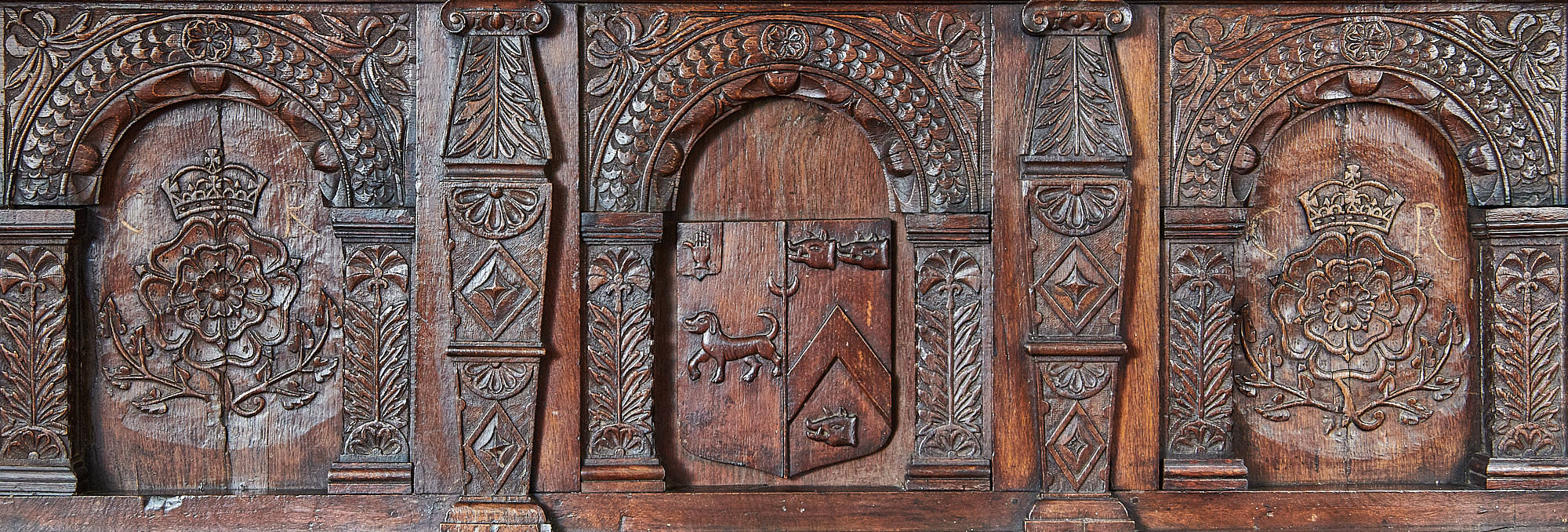Charles I oak carved heraldic overmantel
Circa 1625 - 1640
Colwich, Staffordshire
W 69" × H 23 1/2" × D 5 1/2"
Stock # Marh1903
SOLD
Charles I oak carved heraldic overmantel. The three arcaded panels divided by carved pilasters with ionic capitals and strap work designs, the two outer arcaded panels with leafy decoration and a central carved rose with crown and the initials C R either side of the rose of Charles I. The central panel bearing the marital arms of the Wolseley and Wroughton families.
Argent a talbot passant gules [with the Baronet’s augmentation in the dexter chief] (for Wolseley)
Argent a chevron gules between three boars’ heads couped sable (for Wroughton)
These armorial bearings undoubtedly commemorate the marriage of Sir Robert Wolseley, of Morton and Wolseley in the County of Staffordshire, the 1st Baronet of Wolseley (born 1587 died 21st September 1646) and Mary Wroughton (born 1605 died January 1671). Robert was the second son of John Wolseley, of Morton and his wife, Isabella Porter, whilst his wife, Mary Wroughton was the second daughter of Sir George Wroughton, of Wilcot in the County of Wiltshire and his wife, Ann Gibbs. Robert and Mary were married circa 1630. Robert was created a Baronet within the Baronetage of England on the 24th November 1628. Just prior to Robert being made a baronet, he acquired the family estate of Wolseley from a distant cousin, Sir Thomas Wolseley. Robert served as the Clerk to the King’s Letters Patent as well as a Colonel in the King’s Army. Further, it is recorded that Robert and Mary during the course of their marriage had eleven children, five sons and six daughters. Upon his death in 1646, he was succeeded as the 2nd Baronet of Wolseley by his eldest son, Sir Charles Wolseley (born circa 1630 died 9th October 1714).
Given the dates involved upon the balance of probability and without any evidence to the contrary this over mantel was undoubtedly at one time in situ within the ancient manor house of Wolseley Hall, Colwich which was abandoned after the restoration of the monarchy in 1660 when Sir Robert’s son, Sir Charles Wolseley built a new family seat also named Wolseley Hall a little distance from their old house. Even this ‘new’ house was lost to demolition after suffering a serious fire in the 1950’s. The remains of which were eventually pulled down in 1966.
As a point of interest, the marital arms of Wolseley impaling Wroughton are to be found upon the pedestal of Sir Robert’s impressive monument erected by his family to commemorate his life in the Parish Church of St Michael and All Angels, Colwich.

